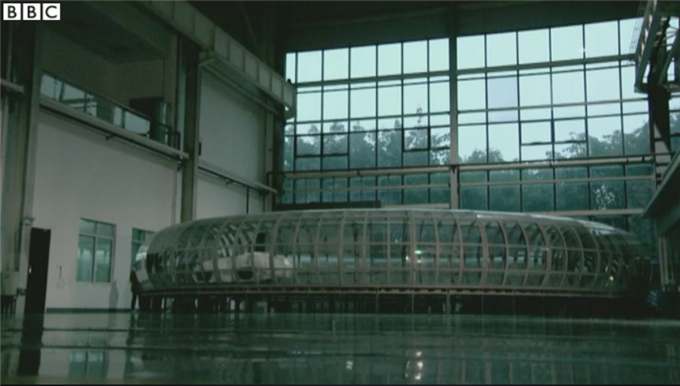The maglev train uses magnetic levitation to move around rather than wheels. There are already speedy methods of transportation, reaching around 430 km/h. But Southwest Jiaotong University, the team wants the trains to go even faster, and to do that, let’s starting small. Here is a model of the super maglev train we’re going to see in action, this is in micro. Now Ms Gou has liquid nitrogen, if you could put the liquid nitrogen into the train, please, I am too scared to do that. Now, that cools metal inside it down, and creates a superconductor there we are, and that should levitate the train, and if I just give a little bit of boost, it not only levitated, but it pushes it around the track. And that’s the same principle as the large model, but it’s a burst of electricity that gives it that initial kick start. The new high temperature super maglevs get their names, because they increase the temperature of the liquid nitrogen, that encases the magnets, but it’s still a very cold minus 196 Celsius, that increases the speed of the train and by placing the whole thing in tube it could really get the speed up. The fact that your operating vacuum here is different, what is the principle behind that? Usually a maglev train gets up to 400km/h, its resistance is from the air, so if we use this evacuated tube we can get speed much higher. This is just a test track here, how long do you think before a train like this will actually be running on the track in China? This kind of technology can be realized after the maglev train gets up to 500km/h, so by the time it reaches between 600-800km/h, it can be commercialized and tested. So I foresee that it will take 30-50 years. Now the next step is to build the straight track and to test it on faster speeds. You have to create a vacuum in the tubes here to make this work, surely in practice that would be fantastically expensive, it’s not a practical technology, this to create a vacuum across large stretches of China? It won’t be as costly as people imagine, in order to maintain a low pressure, usually you need to pump every 2 km, so as long as we keep that it will work, One thought is that we can make use of current underground system, like the Switzerland underground and the US underground. It will take decades more experiment to see if the existing underground tunnels can be converted to accommodate vacuum maglev trains, so the team here uses this track specifically built at the university to test that theories. At the moment, the vacuum tests are only carried out on trains without passengers, so there is still air in the tube when I am inside, but in the future the train will be designed like airplane cabins to deal with the air pressure. What is the difference in the speed you can achieve between when there isn’t a vacuum or when there is a vacuum? With the air the car can go to 16 km/h because of the resistance, when the air is evacuated, the speed can go up to 40 km/h. And theoretically at 3000 km/h, it even has the potential for space travel, but all in good time. I am going 9 km/h, quite fast enough.

http://相关视频
